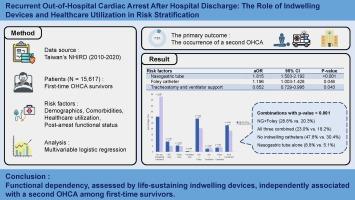出院后复发性院外心脏骤停相关因素:一项基于人群的研究
IF 2.4
Q3 CRITICAL CARE MEDICINE
引用次数: 0
摘要
院外心脏骤停(OHCA)的幸存者仍然有显著的复发风险;然而,与随后需要住院治疗的OHCA发作相关的因素并没有很好地描述。对留置设备的依赖可能表明长期易受攻击的状态。本研究旨在通过全国队列研究确定复发性OHCA的危险因素。方法采用2010 - 2020年台湾全民健康保险研究数据库进行回顾性队列研究。纳入存活出院的成年非创伤性OHCA幸存者,并随访长达5年。分析了人口统计学、合并症、医疗保健利用和长期留置装置(鼻胃管、Foley导管、气管造口伴呼吸机)的使用情况。主要结局是第二次OHCA需要住院治疗。多变量逻辑回归确定了独立的危险因素,并报告了调整后的优势比(aORs)和95%的置信区间(ci)。结果在15617例OHCA幸存者中,1123例(7.2%)在5年内经历了第二次OHCA,需要住院治疗。复发患者年龄较大(62.6岁vs. 61.0岁,p < 0.001),并且更频繁地使用留置器。在多变量分析中,鼻胃管(aOR 1.82, 95% CI 1.50-2.19, p < 0.001)、Foley导管(aOR 1.20, 95% CI 1.00-1.43, p = 0.05)和气管造口伴呼吸机(aOR 0.85, 95% CI 0.73-1.00, p = 0.043)与OHCA复发独立相关,而年龄、性别和停搏前疾病与OHCA复发无关。结论在因复发事件住院的幸存者中,功能依赖和医疗保健利用与复发性OHCA相关。设备依赖可能是漏洞的标志,强调需要持续监测和跟踪。本文章由计算机程序翻译,如有差异,请以英文原文为准。

Factors associated with recurrent out-of-hospital cardiac arrest after hospital discharge: a population-based study
Background
Survivors of out-of-hospital cardiac arrest (OHCA) remain at significant risk of recurrence; however, the factors associated with a subsequent OHCA episode requiring hospitalisation are not well characterised. Dependence on indwelling devices may indicate a state of chronic vulnerability. This study aimed to identify risk factors for recurrent OHCA using a nationwide cohort.
Methods
We conducted a retrospective cohort study using Taiwan’s National Health Insurance Research Database from 2010 to 2020. Adult non-traumatic OHCA survivors discharged alive were included and followed for up to five years. Demographics, comorbidities, healthcare utilisation, and long-term indwelling device use (nasogastric tube, Foley catheter, tracheostomy with ventilator) were analysed. The primary outcome was a second OHCA requiring hospitalisation. Multivariable logistic regression identified independent risk factors, with adjusted odds ratios (aORs) and 95 % confidence intervals (CIs) reported.
Results
Among 15,617 OHCA survivors, 1,123 (7.2 %) experienced a second OHCA requiring hospitalisation within five years. Patients with recurrence were older (62.6 vs. 61.0 years, p < 0.001), and more frequently used indwelling devices. In multivariable analysis, nasogastric tube (aOR 1.82, 95 % CI 1.50–2.19, p < 0.001), Foley catheter (aOR 1.20, 95 % CI 1.00–1.43, p = 0.05), and tracheostomy with ventilator (aOR 0.85, 95 % CI 0.73–1.00, p = 0.043) were independently associated with recurrent OHCA, while age, sex, and pre-arrest diseases were not.
Conclusion
Functional dependence and healthcare utilisation were associated with recurrent OHCA among survivors hospitalised for a recurrent event. Device dependence may serve as a marker of vulnerability, highlighting the need for ongoing monitoring and follow-up.
求助全文
通过发布文献求助,成功后即可免费获取论文全文。
去求助
来源期刊

Resuscitation plus
Critical Care and Intensive Care Medicine, Emergency Medicine
CiteScore
3.00
自引率
0.00%
发文量
0
审稿时长
52 days
 求助内容:
求助内容: 应助结果提醒方式:
应助结果提醒方式:


